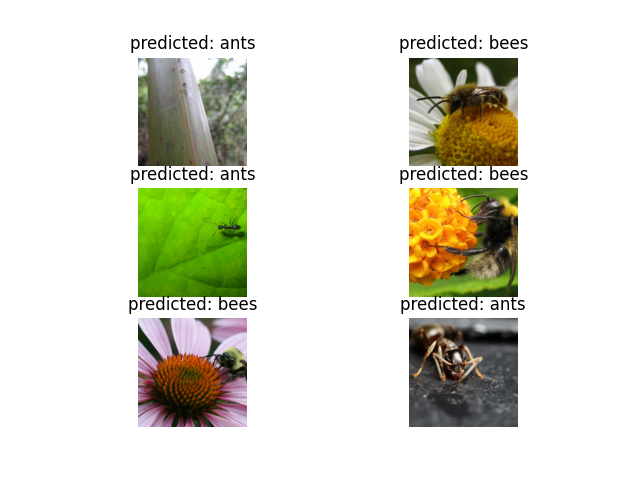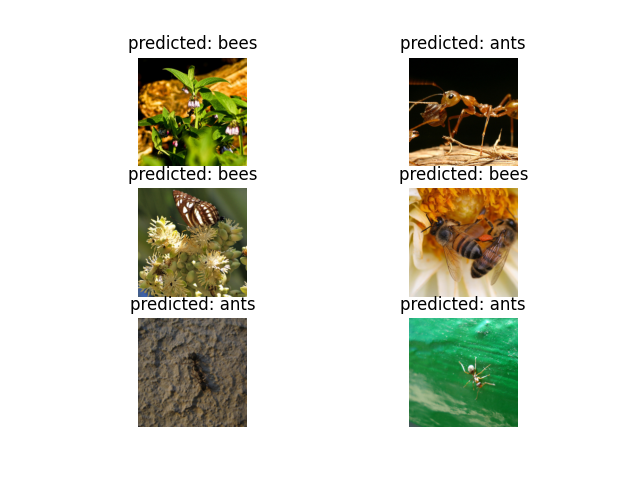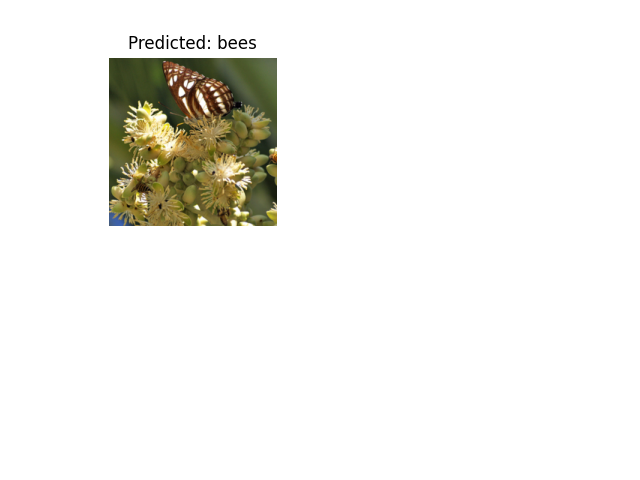Note
Click here to download the full example code
Transfer Learning for Computer Vision Tutorial¶
Author: Sasank Chilamkurthy
In this tutorial, you will learn how to train a convolutional neural network for image classification using transfer learning. You can read more about the transfer learning at cs231n notes
Quoting these notes,
In practice, very few people train an entire Convolutional Network from scratch (with random initialization), because it is relatively rare to have a dataset of sufficient size. Instead, it is common to pretrain a ConvNet on a very large dataset (e.g. ImageNet, which contains 1.2 million images with 1000 categories), and then use the ConvNet either as an initialization or a fixed feature extractor for the task of interest.
These two major transfer learning scenarios look as follows:
Finetuning the ConvNet: Instead of random initialization, we initialize the network with a pretrained network, like the one that is trained on imagenet 1000 dataset. Rest of the training looks as usual.
ConvNet as fixed feature extractor: Here, we will freeze the weights for all of the network except that of the final fully connected layer. This last fully connected layer is replaced with a new one with random weights and only this layer is trained.
# License: BSD
# Author: Sasank Chilamkurthy
import torch
import torch.nn as nn
import torch.optim as optim
from torch.optim import lr_scheduler
import torch.backends.cudnn as cudnn
import numpy as np
import torchvision
from torchvision import datasets, models, transforms
import matplotlib.pyplot as plt
import time
import os
from PIL import Image
from tempfile import TemporaryDirectory
cudnn.benchmark = True
plt.ion() # interactive mode
<contextlib.ExitStack object at 0x7fb73ca72380>
Load Data¶
We will use torchvision and torch.utils.data packages for loading the data.
The problem we’re going to solve today is to train a model to classify ants and bees. We have about 120 training images each for ants and bees. There are 75 validation images for each class. Usually, this is a very small dataset to generalize upon, if trained from scratch. Since we are using transfer learning, we should be able to generalize reasonably well.
This dataset is a very small subset of imagenet.
Note
Download the data from here and extract it to the current directory.
# Data augmentation and normalization for training
# Just normalization for validation
data_transforms = {
'train': transforms.Compose([
transforms.RandomResizedCrop(224),
transforms.RandomHorizontalFlip(),
transforms.ToTensor(),
transforms.Normalize([0.485, 0.456, 0.406], [0.229, 0.224, 0.225])
]),
'val': transforms.Compose([
transforms.Resize(256),
transforms.CenterCrop(224),
transforms.ToTensor(),
transforms.Normalize([0.485, 0.456, 0.406], [0.229, 0.224, 0.225])
]),
}
data_dir = 'data/hymenoptera_data'
image_datasets = {x: datasets.ImageFolder(os.path.join(data_dir, x),
data_transforms[x])
for x in ['train', 'val']}
dataloaders = {x: torch.utils.data.DataLoader(image_datasets[x], batch_size=4,
shuffle=True, num_workers=4)
for x in ['train', 'val']}
dataset_sizes = {x: len(image_datasets[x]) for x in ['train', 'val']}
class_names = image_datasets['train'].classes
device = torch.device("cuda:0" if torch.cuda.is_available() else "cpu")
Visualize a few images¶
Let’s visualize a few training images so as to understand the data augmentations.
def imshow(inp, title=None):
"""Display image for Tensor."""
inp = inp.numpy().transpose((1, 2, 0))
mean = np.array([0.485, 0.456, 0.406])
std = np.array([0.229, 0.224, 0.225])
inp = std * inp + mean
inp = np.clip(inp, 0, 1)
plt.imshow(inp)
if title is not None:
plt.title(title)
plt.pause(0.001) # pause a bit so that plots are updated
# Get a batch of training data
inputs, classes = next(iter(dataloaders['train']))
# Make a grid from batch
out = torchvision.utils.make_grid(inputs)
imshow(out, title=[class_names[x] for x in classes])
![['ants', 'ants', 'ants', 'ants']](png/sphx_glr_transfer_learning_tutorial_001.png)
Training the model¶
Now, let’s write a general function to train a model. Here, we will illustrate:
Scheduling the learning rate
Saving the best model
In the following, parameter scheduler is an LR scheduler object from
torch.optim.lr_scheduler.
def train_model(model, criterion, optimizer, scheduler, num_epochs=25):
since = time.time()
# Create a temporary directory to save training checkpoints
with TemporaryDirectory() as tempdir:
best_model_params_path = os.path.join(tempdir, 'best_model_params.pt')
torch.save(model.state_dict(), best_model_params_path)
best_acc = 0.0
for epoch in range(num_epochs):
print(f'Epoch {epoch}/{num_epochs - 1}')
print('-' * 10)
# Each epoch has a training and validation phase
for phase in ['train', 'val']:
if phase == 'train':
model.train() # Set model to training mode
else:
model.eval() # Set model to evaluate mode
running_loss = 0.0
running_corrects = 0
# Iterate over data.
for inputs, labels in dataloaders[phase]:
inputs = inputs.to(device)
labels = labels.to(device)
# zero the parameter gradients
optimizer.zero_grad()
# forward
# track history if only in train
with torch.set_grad_enabled(phase == 'train'):
outputs = model(inputs)
_, preds = torch.max(outputs, 1)
loss = criterion(outputs, labels)
# backward + optimize only if in training phase
if phase == 'train':
loss.backward()
optimizer.step()
# statistics
running_loss += loss.item() * inputs.size(0)
running_corrects += torch.sum(preds == labels.data)
if phase == 'train':
scheduler.step()
epoch_loss = running_loss / dataset_sizes[phase]
epoch_acc = running_corrects.double() / dataset_sizes[phase]
print(f'{phase} Loss: {epoch_loss:.4f} Acc: {epoch_acc:.4f}')
# deep copy the model
if phase == 'val' and epoch_acc > best_acc:
best_acc = epoch_acc
torch.save(model.state_dict(), best_model_params_path)
print()
time_elapsed = time.time() - since
print(f'Training complete in {time_elapsed // 60:.0f}m {time_elapsed % 60:.0f}s')
print(f'Best val Acc: {best_acc:4f}')
# load best model weights
model.load_state_dict(torch.load(best_model_params_path))
return model
Visualizing the model predictions¶
Generic function to display predictions for a few images
def visualize_model(model, num_images=6):
was_training = model.training
model.eval()
images_so_far = 0
fig = plt.figure()
with torch.no_grad():
for i, (inputs, labels) in enumerate(dataloaders['val']):
inputs = inputs.to(device)
labels = labels.to(device)
outputs = model(inputs)
_, preds = torch.max(outputs, 1)
for j in range(inputs.size()[0]):
images_so_far += 1
ax = plt.subplot(num_images//2, 2, images_so_far)
ax.axis('off')
ax.set_title(f'predicted: {class_names[preds[j]]}')
imshow(inputs.cpu().data[j])
if images_so_far == num_images:
model.train(mode=was_training)
return
model.train(mode=was_training)
Finetuning the ConvNet¶
Load a pretrained model and reset final fully connected layer.
model_ft = models.resnet18(weights='IMAGENET1K_V1')
num_ftrs = model_ft.fc.in_features
# Here the size of each output sample is set to 2.
# Alternatively, it can be generalized to ``nn.Linear(num_ftrs, len(class_names))``.
model_ft.fc = nn.Linear(num_ftrs, 2)
model_ft = model_ft.to(device)
criterion = nn.CrossEntropyLoss()
# Observe that all parameters are being optimized
optimizer_ft = optim.SGD(model_ft.parameters(), lr=0.001, momentum=0.9)
# Decay LR by a factor of 0.1 every 7 epochs
exp_lr_scheduler = lr_scheduler.StepLR(optimizer_ft, step_size=7, gamma=0.1)
Downloading: "https://download.pytorch.org/models/resnet18-f37072fd.pth" to /var/lib/ci-user/.cache/torch/hub/checkpoints/resnet18-f37072fd.pth
0%| | 0.00/44.7M [00:00<?, ?B/s]
36%|###6 | 16.1M/44.7M [00:00<00:00, 169MB/s]
74%|#######4 | 33.2M/44.7M [00:00<00:00, 175MB/s]
100%|##########| 44.7M/44.7M [00:00<00:00, 177MB/s]
Train and evaluate¶
It should take around 15-25 min on CPU. On GPU though, it takes less than a minute.
model_ft = train_model(model_ft, criterion, optimizer_ft, exp_lr_scheduler,
num_epochs=25)
Epoch 0/24
----------
train Loss: 0.4775 Acc: 0.7623
val Loss: 0.3047 Acc: 0.8627
Epoch 1/24
----------
train Loss: 0.5436 Acc: 0.7869
val Loss: 0.6854 Acc: 0.7516
Epoch 2/24
----------
train Loss: 0.4390 Acc: 0.8156
val Loss: 0.2437 Acc: 0.9150
Epoch 3/24
----------
train Loss: 0.6135 Acc: 0.7541
val Loss: 0.3412 Acc: 0.8562
Epoch 4/24
----------
train Loss: 0.4446 Acc: 0.8320
val Loss: 0.2858 Acc: 0.8758
Epoch 5/24
----------
train Loss: 0.5034 Acc: 0.7828
val Loss: 0.3859 Acc: 0.8562
Epoch 6/24
----------
train Loss: 0.3965 Acc: 0.8402
val Loss: 0.4182 Acc: 0.8431
Epoch 7/24
----------
train Loss: 0.4098 Acc: 0.8361
val Loss: 0.2705 Acc: 0.8954
Epoch 8/24
----------
train Loss: 0.2270 Acc: 0.9098
val Loss: 0.2665 Acc: 0.9085
Epoch 9/24
----------
train Loss: 0.2769 Acc: 0.8852
val Loss: 0.2598 Acc: 0.9281
Epoch 10/24
----------
train Loss: 0.3693 Acc: 0.8443
val Loss: 0.2527 Acc: 0.9216
Epoch 11/24
----------
train Loss: 0.3222 Acc: 0.8484
val Loss: 0.3159 Acc: 0.8889
Epoch 12/24
----------
train Loss: 0.2359 Acc: 0.8811
val Loss: 0.2652 Acc: 0.9281
Epoch 13/24
----------
train Loss: 0.3148 Acc: 0.8689
val Loss: 0.2460 Acc: 0.9150
Epoch 14/24
----------
train Loss: 0.2749 Acc: 0.8893
val Loss: 0.3128 Acc: 0.8758
Epoch 15/24
----------
train Loss: 0.3111 Acc: 0.8525
val Loss: 0.2967 Acc: 0.8889
Epoch 16/24
----------
train Loss: 0.2055 Acc: 0.9262
val Loss: 0.2505 Acc: 0.9085
Epoch 17/24
----------
train Loss: 0.2664 Acc: 0.8934
val Loss: 0.2442 Acc: 0.9150
Epoch 18/24
----------
train Loss: 0.2870 Acc: 0.8811
val Loss: 0.2611 Acc: 0.9020
Epoch 19/24
----------
train Loss: 0.2103 Acc: 0.9262
val Loss: 0.2402 Acc: 0.9281
Epoch 20/24
----------
train Loss: 0.2612 Acc: 0.8934
val Loss: 0.2514 Acc: 0.9085
Epoch 21/24
----------
train Loss: 0.2669 Acc: 0.8893
val Loss: 0.3100 Acc: 0.8954
Epoch 22/24
----------
train Loss: 0.3139 Acc: 0.8811
val Loss: 0.2460 Acc: 0.9281
Epoch 23/24
----------
train Loss: 0.2725 Acc: 0.8648
val Loss: 0.2493 Acc: 0.9216
Epoch 24/24
----------
train Loss: 0.2877 Acc: 0.8975
val Loss: 0.2540 Acc: 0.8954
Training complete in 1m 5s
Best val Acc: 0.928105
visualize_model(model_ft)

ConvNet as fixed feature extractor¶
Here, we need to freeze all the network except the final layer. We need
to set requires_grad = False to freeze the parameters so that the
gradients are not computed in backward().
You can read more about this in the documentation here.
model_conv = torchvision.models.resnet18(weights='IMAGENET1K_V1')
for param in model_conv.parameters():
param.requires_grad = False
# Parameters of newly constructed modules have requires_grad=True by default
num_ftrs = model_conv.fc.in_features
model_conv.fc = nn.Linear(num_ftrs, 2)
model_conv = model_conv.to(device)
criterion = nn.CrossEntropyLoss()
# Observe that only parameters of final layer are being optimized as
# opposed to before.
optimizer_conv = optim.SGD(model_conv.fc.parameters(), lr=0.001, momentum=0.9)
# Decay LR by a factor of 0.1 every 7 epochs
exp_lr_scheduler = lr_scheduler.StepLR(optimizer_conv, step_size=7, gamma=0.1)
Train and evaluate¶
On CPU this will take about half the time compared to previous scenario. This is expected as gradients don’t need to be computed for most of the network. However, forward does need to be computed.
model_conv = train_model(model_conv, criterion, optimizer_conv,
exp_lr_scheduler, num_epochs=25)
Epoch 0/24
----------
train Loss: 0.6996 Acc: 0.6516
val Loss: 0.2014 Acc: 0.9346
Epoch 1/24
----------
train Loss: 0.4233 Acc: 0.8033
val Loss: 0.2656 Acc: 0.8758
Epoch 2/24
----------
train Loss: 0.4603 Acc: 0.7869
val Loss: 0.1847 Acc: 0.9477
Epoch 3/24
----------
train Loss: 0.3096 Acc: 0.8566
val Loss: 0.1747 Acc: 0.9477
Epoch 4/24
----------
train Loss: 0.4427 Acc: 0.8156
val Loss: 0.1630 Acc: 0.9477
Epoch 5/24
----------
train Loss: 0.5505 Acc: 0.7828
val Loss: 0.1643 Acc: 0.9477
Epoch 6/24
----------
train Loss: 0.3004 Acc: 0.8607
val Loss: 0.1744 Acc: 0.9542
Epoch 7/24
----------
train Loss: 0.4083 Acc: 0.8361
val Loss: 0.1892 Acc: 0.9412
Epoch 8/24
----------
train Loss: 0.4483 Acc: 0.7910
val Loss: 0.1984 Acc: 0.9477
Epoch 9/24
----------
train Loss: 0.3335 Acc: 0.8279
val Loss: 0.1942 Acc: 0.9412
Epoch 10/24
----------
train Loss: 0.2413 Acc: 0.8934
val Loss: 0.2001 Acc: 0.9477
Epoch 11/24
----------
train Loss: 0.3107 Acc: 0.8689
val Loss: 0.1801 Acc: 0.9412
Epoch 12/24
----------
train Loss: 0.3032 Acc: 0.8689
val Loss: 0.1669 Acc: 0.9477
Epoch 13/24
----------
train Loss: 0.3587 Acc: 0.8525
val Loss: 0.1900 Acc: 0.9477
Epoch 14/24
----------
train Loss: 0.2771 Acc: 0.8893
val Loss: 0.2317 Acc: 0.9216
Epoch 15/24
----------
train Loss: 0.3064 Acc: 0.8852
val Loss: 0.1909 Acc: 0.9477
Epoch 16/24
----------
train Loss: 0.4243 Acc: 0.8238
val Loss: 0.2227 Acc: 0.9346
Epoch 17/24
----------
train Loss: 0.3297 Acc: 0.8238
val Loss: 0.1916 Acc: 0.9412
Epoch 18/24
----------
train Loss: 0.4235 Acc: 0.8238
val Loss: 0.1766 Acc: 0.9477
Epoch 19/24
----------
train Loss: 0.2500 Acc: 0.8934
val Loss: 0.2003 Acc: 0.9477
Epoch 20/24
----------
train Loss: 0.2413 Acc: 0.8934
val Loss: 0.1821 Acc: 0.9477
Epoch 21/24
----------
train Loss: 0.3762 Acc: 0.8115
val Loss: 0.1842 Acc: 0.9412
Epoch 22/24
----------
train Loss: 0.3485 Acc: 0.8566
val Loss: 0.2166 Acc: 0.9281
Epoch 23/24
----------
train Loss: 0.3625 Acc: 0.8361
val Loss: 0.1747 Acc: 0.9412
Epoch 24/24
----------
train Loss: 0.3840 Acc: 0.8320
val Loss: 0.1768 Acc: 0.9412
Training complete in 0m 33s
Best val Acc: 0.954248
visualize_model(model_conv)
plt.ioff()
plt.show()

Inference on custom images¶
Use the trained model to make predictions on custom images and visualize the predicted class labels along with the images.
def visualize_model_predictions(model,img_path):
was_training = model.training
model.eval()
img = Image.open(img_path)
img = data_transforms['val'](img)
img = img.unsqueeze(0)
img = img.to(device)
with torch.no_grad():
outputs = model(img)
_, preds = torch.max(outputs, 1)
ax = plt.subplot(2,2,1)
ax.axis('off')
ax.set_title(f'Predicted: {class_names[preds[0]]}')
imshow(img.cpu().data[0])
model.train(mode=was_training)
visualize_model_predictions(
model_conv,
img_path='data/hymenoptera_data/val/bees/72100438_73de9f17af.jpg'
)
plt.ioff()
plt.show()

Further Learning¶
If you would like to learn more about the applications of transfer learning, checkout our Quantized Transfer Learning for Computer Vision Tutorial.
Total running time of the script: ( 1 minutes 41.584 seconds)